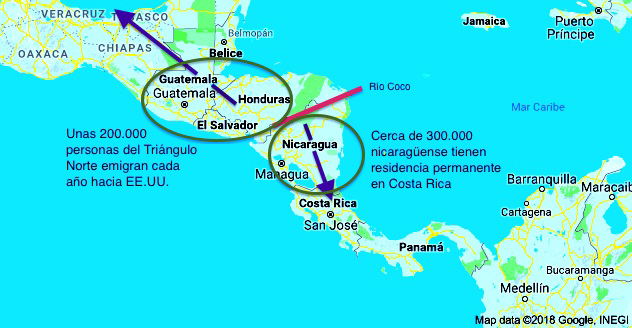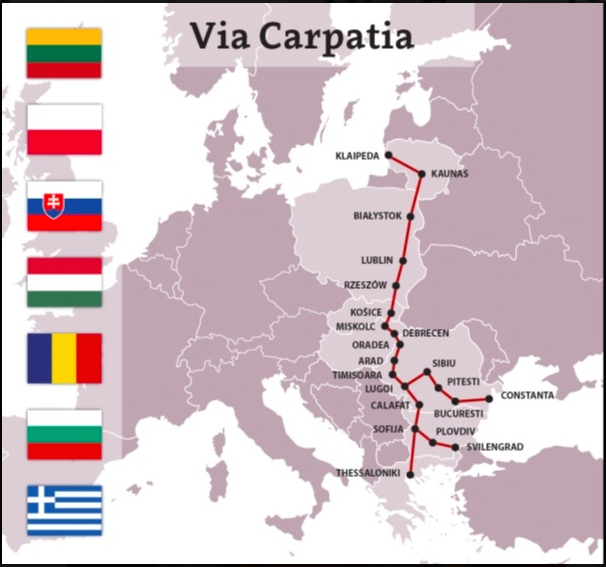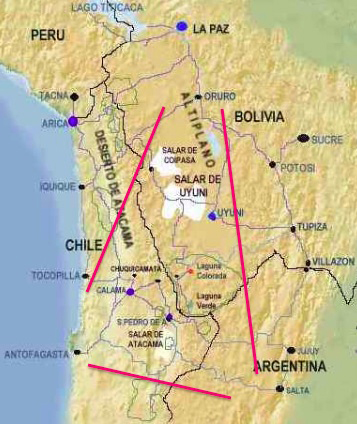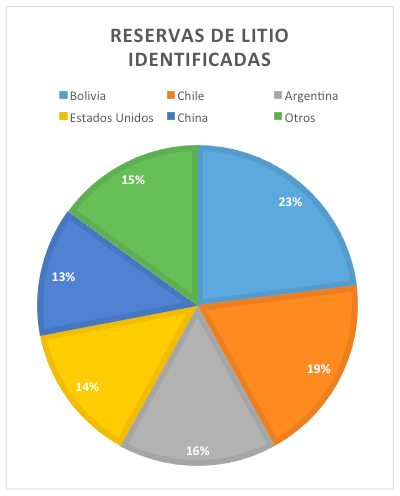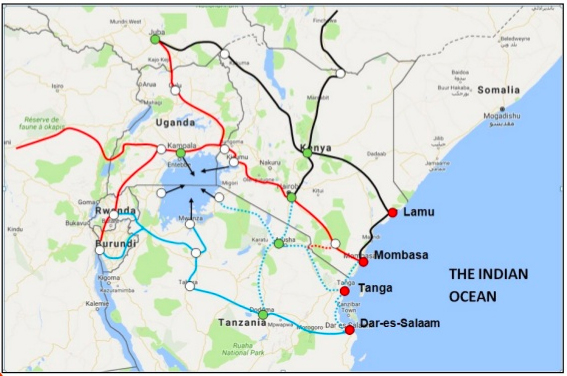Ruta de navegación
Menú de navegación
Blogs
Entries with Categories Global Affairs Articles .
Trump has maintained several of the measures passed by Obama, but has conditioned their implementation
Donald Trump has not closed the embassy opened by Barack Obama in Havana and has kept to the letter of the rules allowing only certain travel by Americans to the island. However, his imposition of not establishing commercial or financial relations with companies controlled by the Cuban military-police apparatus has affected the volume of exchanges. But it has been above all his anti-Castro rhetoric that has brought the relationship almost back to the Cold War.
![Barack Obama and Raúl Castro, at the baseball game they attended during the U.S. president's 2016 visit to Cuba visit [Pete Souza/White House]. Barack Obama and Raúl Castro, at the baseball game they attended during the U.S. president's 2016 visit to Cuba visit [Pete Souza/White House].](/documents/10174/16849987/eeuu-cuba-blog.jpg)
▲Barack Obama and Raúl Castro, at the baseball game they attended during the U.S. president's 2016 visit to Cuba [Pete Souza/White House].
article / Valeria Vásquez
For more than half a century, relations between the United States and Cuba were marked by political tensions. The last years of Barack Obama's presidency marked a significant change with the historic reestablishment of diplomatic relations between the two countries and the approval of certain measures of U.S. openness toward Cuba. The White House then hoped that the climate of growing cooperation would boost the modest economic reforms that Havana had begun to implement earlier and that all this would eventually bring political transformations to the island.
The Cuban government's lack of concessions on subject regarding freedoms and human rights, however, was used by Donald Trump to reverse, upon his arrival to power, several of the measures approved by his predecessor, although it has been above all his anti-Castro rhetoric that has created a new hostile environment between Washington and Havana.
Obama era: détente
In his second term, Barack Obama began secret negotiations with Cuba that culminated with the advertisement in December 2014 of a agreement for the reestablishment of diplomatic relations between the two countries. The respective embassies were reopened in July 2015, thus overcoming an anomaly dating back to 1961, when the Eisenhower Administration decided to break relations with the West Indian neighbor in view of the communist orientation of the Cuban Revolution. In March 2016, Obama became the first U.S. president to visit Cuba in 88 years.
Beyond the diplomatic sphere, Obama also sought an economic opening towards the island. Given that lifting the embargo established by the US for decades required the approval of the congress, where he faced a Republican majority, Obama introduced certain liberalizing measures by means of presidential decrees. Thus, he eased travel restrictions (he hardly changed the letter of the law, but he did relax his internship) and authorized an increase in the volume of purchases that Americans could make in Cuba.
For Obama, the economic embargo was a failed policy, as it had not achieved its purpose goal of ending the Cuban dictatorship and, consequently, had prolonged it. For this reason, he was betting on a change of strategy, in the hope that the normalization of relations -diplomatic and, progressively, economic- would help to improve Cuba's social status and contribute, in the medium or long term deadline, to the change that the economic embargo had failed to bring about. According to Obama, the embargo had had a negative impact, since issues such as the limitation of tourism or the lack of foreign direct investment had affected the Cuban people more than the Castro nomenklatura.
A new economic relationship
Faced with the impossibility of lifting the economic embargo on Cuba, Obama opted for presidential decrees that opened up trade relations between the two countries. Several measures were aimed at facilitating better access to the Internet for Cubans, which should help to promote democratizing demands in the country. Thus, Washington authorized U.S. telecommunications companies to establish business in Cuba.
In the financial field, the United States allowed its banks to open accounts in Cuba, which facilitated transactions. In addition, Cuban citizens residing on the island could receive payments in the U.S. and send them back to their country.
Another of the measures adopted was the lifting of some of the travel restrictions. As required by U.S. legislation, Obama maintained the restriction that Americans can only travel to Cuba under various circumstances, all linked to certain missions: academic, humanitarian, religious support trips.... Although purely tourist trips were still excluded, the lack of control that the U.S. authorities deliberately stopped applying meant a considerable opening of the hand.
In addition to authorizing banking transactions related to such travel, to meet the anticipated increase in tourists, it was announced that several U.S. carriers such as JetBlue and American Airlines had received approval to fly to Cuba. For the first time in 50 years, in late November 2016 a U.S. commercial aircraft landed in Havana.
The U.S. president also eliminated the limit of expense that U.S. visitors had on the purchase of products for use staff (particularly cigars and rum). Likewise, he promoted the partnership in the medical research and approved the importation of medicines produced in Cuba.
In addition, Obama repealed the "wet foot, dry foot" policy, whereby Cubans arriving on U.S. soil were automatically granted political asylum, while only those intercepted by Cuba at sea were returned to the island.
Trump's review
Since his electoral campaign, Donald Trump showed clear signals about the direction his relations with Cuba would take if he became president. Trump announced that he would reverse the opening towards Cuba carried out by Obama, and as soon as he arrived at the White House he began to strengthen the anti-Castro speech in Washington. The new president said he was willing to negotiate a "better agreement" with the island, but on the condition that the Cuban government showed concrete progress towards the democratization of the country and respect for human rights. Trump raised the prospect of free elections and the release of political prisoners, knowing that the Cuban regime would not accede to these requests. In the absence of a response from Havana, Trump insisted on his previous proposals: maintenance of the embargo (which in any case the Republican majority in the congress is not willing to lift) and reversal of some of Obama's decisions.
In reality, Trump has formally maintained several of his predecessor' s measures, although the ban on doing business with companies controlled by the Revolutionary Armed Forces (FAR), which dominate a good part of Cuban economic life, and the respect for the letter in travel restrictions have reduced the contact between the US and Cuba that had begun to occur at the end of the Obama era.
Trump has ratified the repeal of the "wet foot, dry foot" policy decided by Obama and has maintained the diplomatic relations reestablished by Obama (although he has paralyzed the appointment of an ambassador). It has also respected the timid commercial and financial opening operated by the Democratic president, but as long as the economic transactions do not take place with companies linked to the Cuban Army, intelligence and security services. In this regard, the department of the Treasury published on November 8, 2017 a list of companies in those sectors with which no subject of contact US fits.
Regarding travel, the restricted assumptions for American travel to the island are maintained, but in contrast to the blind eye adopted by the Obama Administration, the Trump Administration requires that Americans who want to go to Cuba must do so on tours conducted by American companies, accompanied by a representative of the group sponsor and with the obligation to communicate the details of their activities. The Treasury's rules and regulations requires that stays be in private hostels (casas particulares), meals in restaurants run by individuals (paladares) and shopping in stores run by citizens (cuentapropistas), with the purpose to "channel funds" away from the Cuban army and weaken communist policy.
Reduced tourist expectations led already at the end of 2017 to the fact that several US airlines had cancelled all their flights to the Caribbean island. The Cuban Economics had counted on a large increase in US tourists and yet now had to face, without higher revenues, the serious problem of falling shipments of cheap oil from Venezuela.
Future of diplomatic relations
The greatest tension between Washington and Havana, however, has not been in the commercial or economic sphere, but in the diplomatic sphere. Following a series of apparent "sonic attacks" on U.S. diplomats in Cuba, the U.S. recalled much of its staff in Cuba and expelled 15 diplomats from the Cuban embassy in Washington. In addition, the department of State made a recommendation not to travel to the island. Although the origin of these alleged attacks, which the Cuban authorities deny having carried out, has not been clarified, it could be the accidental side effect of an espionage attempt, which would have eventually caused brain damage to the people being monitored.
The future of relations between the two countries will depend on the direction taken by Trump's policies and the pace of reforms that the new Cuban president may establish. Given that not many changes are foreseen in Miguel Díaz-Canel's management , at least as long as Raúl Castro lives, Havana's immobility in the political and economic fields would probably continue to run up against Trump's anti-revolutionary rhetoric.
The EU has backed down on the project, but Germany still gives support to the Russian initiative
The project of a second set of gas pipelines through the Baltic Sea, in order to transport Russian gas to the European Union without crossing Ukraine, has divided the EU governments. Some Eastern and Central European countries, backed by the United States, argue against any dependency on Russian gas supplies, but Germany keeps its support to the Russian plans.
![The routes of the Nord Stream and the planned Nord Stream 2 pipelines from Russia to Germany [Gazprom]. The routes of the Nord Stream and the planned Nord Stream 2 pipelines from Russia to Germany [Gazprom].](/documents/10174/16849987/nordstream-blog.jpg)
▲The routes of the Nord Stream and the planned Nord Stream 2 pipelines from Russia to Germany [Gazprom].
ARTICLE / Ane Gil Elorri
The natural gas consumption for nowadays is essential to have basic necessities covered. Therefore, it's imperative for everyday life. Nevertheless, it goes through a laborious process before it reaches the consumers. The gas needs to be extracted from the land or sea subsurface, and transported, before it reaches its destiny, being pipelines the most common via of transportation.
The EU's domestic gas production has been declining and the reserves in the North Sea depleted. Therefore, in order to meet demands, the EU has turned to other suppliers; being the most important Russia, Saudi Arabia and Norway. In fact, a lot of countries in the European Union are heavily dependent on Russian imports, especially of natural gas, which often go through transit countries such as Ukraine and Belarus. The decisions are all make through the EU-Russia Energy Dialogue. Russia has the largest gas reserves in the world. With 44,600 billion cubic meters, Russia has 23.9 percent of the world's currently known gas reserves, followed by Iran (15.8 percent), Qatar (13.5 percent), the United States, and Turkmenistan (4.3 percent each).
The most prominent European energy supply is the Nord Stream Pipelines. Nord Stream are a twin set of pipelines that provide gas transportation capacity for the natural gas, which comes from the Western Russia (Vyborg) into Lubmin, Germany, for the distribution into the European gas grid. This system is composed by a set of 1,224-kilometre pipelines through the Baltic Sea, and each hold the capacity to transport 27.5 billion cubic metres of natural gas a year. Line 1 became operational in November 2011 and by October 8, 2012 the system was fully operational, having taken the construction of these pipelines 30 months.
The desire of a grand-scale gas transport between Russia and the western Europe goes back to the 1970's, to the contract between a German company (Ruhrgas AG) and Gazprom (national Russian gas company) to supply natural gas. In 2000 the European Commission recognized the need for a pipeline in the Baltic Sea. In December 2005, the North European Gas Pipeline Company was established and by October 4, 2006, the North European Gas Pipeline was officially renamed Nord Stream. It was finally completed and functional in October 2012.
The Nord Stream project was very ambitious. Nevertheless, it was completed on time, on budget, and without permanently impacting the environment. The Nord Stream Pipeline system is fully operational and capable of transporting up to 55 billion cubic metres (bcm) of natural gas every year to Europe.
Now, a new project is developing based on the success of the Nord Stream Pipelines: Nord Stream 2. This project will benefit from the experience of the previous pipeline, which has set a new high for the environmental, technical and safety standards throughout its planning, construction and operation. The idea is to add a new set of twin pipelines along the Baltic Sea route to increase the capacity of gas transportation in order to meet the demands of Europe. In fact, this new pipeline will create a direct link between Gazprom and the European consumers.
The Nord Stream 2 project is implemented by the Nord Stream 2 AG project company, where Gazprom is the sole shareholder. In October 2012, the shareholders of the Nord stream project examined the possibility of constructing a third and fourth pipeline and came to the conclusion that it was economically and technically attainable. In April 2017, Nord Stream 2 AG signed the financing agreements for the Nord Stream 2 gas pipeline project with ENGIE, OMV, Royal Dutch Shell, Uniper, and Wintershall. These five European energy companies will provide long-term financing for 50 per cent of the total cost of the project.
The entry point into the Baltic Sea of the twin pipeline will be the Ust-Luga area of the Leningrad Region. Then the pipeline will stretch across the Baltic Sea. Its exit point in Germany will be in the Greifswald area close to the exit point of the original Nord Stream. The route covers over 1,200 kilometres.
The total capacity of the second twin set of pipelines is 55 billion cubic metres of gas per year. Therefore, the sum with the prior pipelines would give an outstanding number of 110 billion cubic metres of gas per year. Nord Stream 2 will be operational before late 2019.
This project is defended with the argument that it supposed a diversification of the routs transporting natural gas to Europe and to elevate the energetic security due to the instability of the transit of gas through Ukraine. For now, a lot of the natural gas consumed by Europe comes from Russia through Ukraine. Nevertheless, if this project goes through, Ukraine will lose 2,000 million dollars for the transit of natural gas, and even the proportion of gas will decrease (which is also for staff use) leading to the collapse and finalization of the transit of natural gas through Ukraine. Furthermore, if Hungary, Slovakia and Poland receive natural gas through the Nord Stream 2 pipelines instead of through Ukraine, it will be very difficult that Ukraine receives gas from the west, seeing as Gazprom along with others controls EUGAL (European Gas Pipeline Link) can reduce the supply of gas to those companies that provide gas to Ukraine.
The cost of 1,000 cubic meters in 100 kilometres through Nord Stream 2 would cost 2.1 million dollars while through Ukraine it costs 2.5 million dollars. The tariff of transportation of natural gas through Nord Stream is 20% lower than through Ukraine.
|
The main Russian gas pipelines to Eastern and Central Europe [Samuel Bailey/CC]. |
Only half of the European Union members approve the negotiations between the EU and Russia over the Nord Stream 2 Project. It is true that the natural gas demand of Europe is growing each year but some countries such as the Baltics are against anything that has to do with Russia. Besides the US, thanks to fracking, has become the biggest producer of gas, and is now looking to substitute Russia as the main gas supplier of the EU.
But other countries are in favour of this project. In January 31 this year, Germany gave its permission to begin the construction of the pipelines of Nord Stream 2 in their territorial waters. Berlin also authorized the construction of the section of 55 kilometres that will go through the terrestrial part situated in Lubmin. In April this year, Finland has also given the two permissions needed to begin the construction.
Nevertheless, Gazprom will be facing a few difficulties in order to pull through with this project. The company still needs that other countries, such as Norway, Denmark and Russia, give authorizations and permissions to construct the pipelines in their exclusive economic zone. There is a risk that Denmark doesn't authorize these new pipelines. The Danish Agency of Energy and the Foreign Office both have to give their approval but can deny the permit if Nord Stream 2 represents a danger for the environment. Another problem is purely political: the European Commission is trying to make the implementation of the project fit with the EU legislation. In November 2017, the European Commission prepared a list of amendments to its energy legislation, known as the Third Energy Package, which will pursue gas pipelines that come from the markets of countries that have the Brussels standards. Because of this, Gazprom won't be able to be the only shareholder of the Nord Stream 2 project and the pipelines will have to carry gas of other companies that have nothing to do with Gazprom.
Although, as previously mentioned, Nord Stream 2 has already received the two permits necessary in Germany and Finland in order to begin the construction, it seems that not many European countries are in favour of this project. In fact, since this April, the EU and the European Commission have withdrawn their support claiming that Nord Stream 2 does not encourage the diversification of gas supply, and they give more significance to the gas pipelines going through the Ukrainian territory in context of diversification of supply routes.
Other EU countries and of the region, such as Ukraine, Denmark, the Baltic States and Poland, have continuously spoken against Nord Stream 2, claiming that the project will increase Europe's dependence on imported Russian gas. Nevertheless, German Chancellor Angela Merkel supports this project, considering it to be an economic project which does not pose a threat to EU energy security, has is expected, seeing as the Nord Stream 2 is a joint venture between Russia's Gazprom, France's Engie, Austria's OMV AG, the Anglo-Dutch company Royal Dutch Shell, and Uniper and Wintershall, both German.
Nevertheless, the most vocally active countries against this project are the US and Ukraine. On one side, the United States believes that this project would undermine Europe's overall energy security and stability. It would also provide Russia other ways to pressure European countries, especially Ukraine. The US even threatened the EU firms to be subjected to Countering America's Adversaries Through Sanctions Act (CAATSA). On the other side, Ukraine's efforts to prevent the implementation of Nord Stream appears to be futile. They openly stated that this would conclude on the Russian monopoly on the world gas market, which would lead in Europe to an energy crisis and to an economic and political destabilization, and called for the international community to step in. Unfortunately, Germany is as headstrong as ever, stating that underwater pipeline to bring gas from Russia could not go forward without Ukrainian involvement in overland transit.
As the recent expulsion of European diplomats in Moscow shows, the global political relations have worsened considerably in the last few years. In fact, some would say that it the worst condition since the Cold War. This new political situation has had consequences on the Nord Stream 2, causing European countries to oppose to this project. The ultimate defender left standing of the programme is Germany, even the EU has backed down after Ukraine's protest. Ukraine has every right to oppose to this project, seeing as Russia has had nothing more but cold moves towards this country(cut off gas supplies in the middle of winter, Crimea), and is not outrageous to think that this project would ultimately affect the country, especially economically. Therefore, this project does not diversify the sources of natural gas, the first Nord Stream already reached this objective. The second Nord Stream, however, would grant Russia a monopoly of natural gas, which is not recommendable seeing as it would create Europe's dependence on Russia, and Russia could take advantage of it. Unfortunately, Russia will not give up this project, even with mostly everybody turns against it.
Opportunities and challenges in Sino-Panamanian relations, one year after the establishment of diplomatic relations
In June 2016, Panama inaugurated the expansion of its Canal. In June 2017, the Panamanian government decided to establish diplomatic relations with China (Central America has been a traditional ally of Taiwan), thus giving rise to the flow of new Chinese investments in a Canal revitalized with the expansion. On the one-year anniversary of the establishment of relations, here is a review of the opportunities and challenges posed by the increased Chinese presence in the isthmus.
![Container ship of the Chinese shipping company COSCO, making transit issue 2,000 in the expanded Canal, in September 2017 [Panama Canal]. Container ship of the Chinese shipping company COSCO, making transit issue 2,000 in the expanded Canal, in September 2017 [Panama Canal].](/documents/10174/16849987/canal-panama-blog.jpg)
▲Container ship of the Chinese shipping company COSCO, making transit issue 2,000 in the expanded Canal, in September 2017 [Panama Canal].
article / Ximena Barria
In the last decade, the People's Republic of China has made efforts to increase its presence in different regions of the world. China's projection as a global power has meant that no region is alien to it and there are hardly any countries that do not actively seek commercial exchange with the Asian giant. Therefore, it is not surprising that China has wanted to increase its activity around the Panama Canal, and that this Central American country has established diplomatic relations with Beijing, breaking the traditional relationship with Taiwan.
Panama's privileged geography and its rapid economic growth in the region are two important aspects taken into account by China. The Panama Canal offers advantageous access to the Atlantic and Pacific oceans and about 6% of global maritime trade passes through it. At times there has been talk of Chinese interest in building a canal in Nicaragua, something that was never really on Beijing's diary . China sees Panama as an important geostrategic point from which to project its foreign policy in Latin America, which undoubtedly unsettles Washington.
On June 13, 2017, the Republic of Panama and the People's Republic of China announced the establishment of diplomatic relations. With this, Panama recognized the government of Beijing as the legitimate Chinese government and broke the previous diplomatic relations established with Taipei. The new Sino-Panamanian relations gave way to 19 agreements in various areas.
Chinese projects in the isthmus
In a country as open to trade and transactions of all subject as Panama is, the population of Chinese origin has always had a relative presence. The Chinese community in Panama is made up of some 135,000 people, which represents 4% of its 4 million inhabitants.
Since 1911, Panama had maintained diplomatic relations with China. However, after the defeat of the Chinese Nationalist Party and the victory of Mao Zedong's communism, the Panamanian State decided to maintain diplomatic relations with Taiwan, due to its capitalist stance, during the Cold War. Since 1949, Panama remained one of Taiwan's major allies until its rupture in 2017.
Despite the recognition of Taipei, trade relations between Panama and the People's Republic of China have been increasing in recent years, generating a larger volume of exchange than that recorded between the Central American country and Taiwan.
Panama's most important economic engine is the Canal, which links the Atlantic and Pacific oceans and constitutes one of the most important routes for world trade. Canal revenues generate one third of Panama's Gross Domestic Product. Over the years, China has become an important customer of the Canal, becoming its second largest customer Username after the United States. The first ship to cross the expanded Canal, at the inauguration held in June 2016, was a vessel of the Chinese shipping company COSCO, which was awarded the honor by lottery.
China is the largest provider of the Colon Free Zone (CFZ), located on the Caribbean coast of Panama, next to the northern mouth of the Canal. It is the most important free zone in the Americas and the second largest in the world, with an annual volume of imports and re-exports of $16.16 billion. In the first semester of 2017, the FTZ imported $1.344 billion worth of goods from China. Likewise, important Chinese companies have sought to establish themselves in the FTZ taking advantage of the strategic advantages it offers.
China has also announced the construction of a container port at area in Colon, which will have facilities for receiving liquefied natural gas. The planned construction is estimated to cost $900 million. The construction will result in the first container terminal designed to handle Neopanamax ships, which have the maximum dimensions to transit the canal.
In the area of communications, the People's Republic of China expressed its interest in building a railway infrastructure connecting the capital of Panama and the province of Chiriqui, covering a distance of 400 kilometers. As for air transportation, the Air China airline committed to operate the Panama City-Beijing route twice a week. Panama has the most important air hub in Latin America and having a direct flight to Beijing represents an important opportunity to bring Asian markets closer to Latin America.
In addition, Panama has an important and diversified financial center that is attractive to Chinese banks as a strategic gateway to establish themselves in the region. The presence of Bank of China, with more than 30 years in the country, and future establishments of other entities such as Banco Industrial y Comercial, Exim Bank and China Development Bank will contribute to increase the flow of Chinese capital to Panama. This, in turn, will diversify and make Panama's banking sector increasingly dynamic.
The Panamanian challenge to take advantage of the opportunity
Ensuring that this increased relationship with China and the Asian market structurally benefits Panama and does not degenerate into a future status of dependence presents important challenges for a country that is in the process of development. Panama will have to increase productivity in sectors such as agriculture and industry, train more staff and create a transparent framework of financial institutions.
The agricultural sector presents marketing difficulties and a lack of agricultural policies to produce and sell crops at fair prices. In recent years, there has been a shortage of land for crop marketing purposes as a result of droughts and floods. Another challenge is food imports, since many imported foreign products are cheaper and this causes a drop in the prices of domestic products, which makes their production unprofitable for the farmer.
The increase in industrial productivity goes hand in hand with the effort of training of a better human capital. Currently, in the Panamanian republic there is a lack of preparation of people who can manage important companies. In 2015, the issue of enrolled in universities reached only a meager issue of 160,000 students. The Panamanian government should promote technical training projects and scholarships to increase this issue so that in the long term deadline there will be more staff trained for the new companies that will arrive.
The Panamanian financial structure should also be prepared to create new legislation that will contribute to legal certainty. In order to harmonize the financial sector with international anti-money laundering conventions, the Panamanian government should establish tax reforms that promote fiscal transparency. The entry of foreign banks should be regulated more effectively. The discussion to consider classifying tax evasion as a tax crime will present an important challenge for the country to consider.
Central America's Northern Triangle migrants look to the U.S., Nicaragua's to Costa Rica
While migrants from Guatemala, El Salvador and Honduras continue to try to reach the United States, those from Nicaragua have preferred to travel to Costa Rica in recent years. The restrictions put in place by the Trump Administration and the deterioration of the Costa Rican economic boom are reducing the flows, but this migratory divide in Central America remains for the time being.
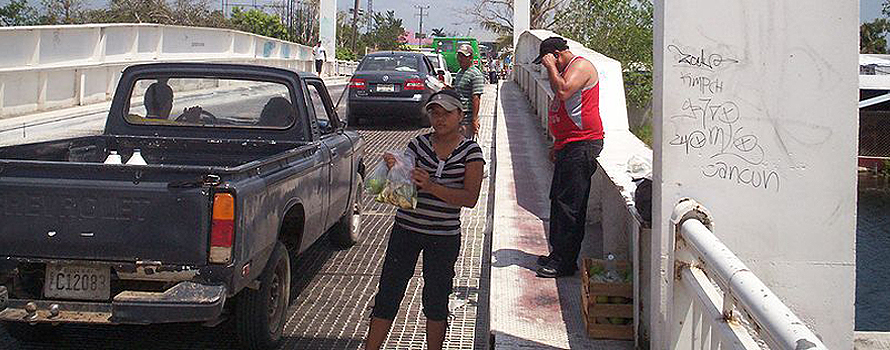
▲Belize-Mexico border crossing [Marrovi/CC].
article / Celia Olivar Gil
When comparing the Degree of development of the Central American countries, the different human flows operating in the region are well understood. The United States is the great migratory magnet, but Costa Rica is also to some extent a pole of attraction, evidently to a lesser extent Degree. Thus, the five Central American countries with the highest poverty rates -Guatemala, El Salvador, Honduras, Nicaragua and Belize- share their migratory orientation: the first four maintain important flows to the United States, while in recent years Nicaragua has opted more for Costa Rica, given its proximity.
Migration from the Northern Triangle to the U.S.
Nearly 500,000 people try every year to cross Mexico's southern border with the goal to reach the United States. Most of them come from Guatemala, El Salvador and Honduras, the Central American region known as the Northern Triangle, which is currently one of the most violent in the world. The reasons that lead this high issue number of citizens from the Northern Triangle to migrate, many illegally, are various:
On the one hand, there are reasons that could be described as structural: the porousness of the border, the complexity and high costs of regularization processes for migration, the lack of commitment by employers to regularize migrant workers, and the insufficient capacity of governments to establish migration laws.
There are also clear economic reasons: Guatemala, Honduras and El Salvador have high poverty rates, at 67.7%, 74.3% and 41.6%, respectively, of their inhabitants. presentation Difficulties in budgetary income and pronounced social inequality mean that public services, such as Education and healthcare, are deficient for a large part of the population.
Perhaps the most compelling reason is the lack of security. Many of those leaving these three countries cite insecurity and violence as the main reason for their departure. The level of criminal violence in the Northern Triangle reaches levels similar to those of an armed conflict. In El Salvador, a total of 6,650 intentional homicides were registered in 2015; in Honduras, 8,035, and in Guatemala, 4,778.
All these reasons push Guatemalans, Salvadorans and Hondurans to migrate to the United States, who on their journey north use three main routes to cross Mexico: the one that crosses the country diagonally until reaching the area of Tijuana, the one that advances through central Mexico to Ciudad Juarez and the one that seeks to enter the US through the Rio Bravo valley. subject Along these routes, migrants face many risks, such as falling victim to criminal organizations and suffering all kinds of abuses (kidnapping, torture, rape, robbery, extortion...), which can not only cause immediate physical injuries and trauma, but can also leave serious long-term consequences deadline.
Despite all these difficulties, citizens of the Northern Triangle continue to choose the United States as their migration destination. This is mainly due to the attraction of the economic potential of a country like the USA, at status of plenary session of the Executive Council employment ; to its relative geographic proximity (it is possible to arrive by land crossing only one or two countries), and to the human relations created since the 1980s, when the USA began to be goal for those fleeing the civil wars of a politically unstable Central America with economic difficulties, which created a migratory tradition, consolidated by family connections and the protection offered to the newcomers by the already established nationals. During this period, the Central American population in the U.S. tripled. Today, 82.9% of Central American immigrants in the U.S. live in the United States.
|
The American immigration 'watershed' [with ABC's authorization]. |
Migration from Nicaragua to Costa Rica
If emigration from northern Central America has been directed towards the United States, emigration from southern Central America has had more destinations. If Hondurans have looked to the north, in recent years their Nicaraguan neighbors have looked somewhat more to the south. The Coco River, which divides Honduras and Nicaragua, has become a sort of migratory'watershed'.
Certainly there are more Nicaraguans officially residing in the U.S. (over 400,000) than in Costa Rica (close to 300,000), but in recent years the issue of new residents has increased more in Costa Rican territory. In the last decade, from agreement with an OAS report (pages 159 and 188), the US has granted permanent residency program permission to a average of 3,500 Nicaraguans each year, while Costa Rica has granted about 5,000 from average, reaching a record 14,779 in 2013. Moreover, the proportional weight of Nicaraguan migration in Costa Rica, a country of 4.9 million inhabitants, is large: in 2016, some 440,000 Nicaraguans entered the neighboring country, and as many exits were recorded, indicating a significant cross-border mobility and suggesting that many workers temporarily return to Nicaragua to circumvent the requirements de extranjería.
Costa Rica is seen in certain aspects in Latin America as Switzerland in Europe, that is, as an institutionally solid, politically stable and economically favorable country. This means that the emigration of Costa Ricans is not extreme and that people come from other places, so that Costa Rica is the country with the highest net migration in Latin America, with 9% of the Costa Rican population of foreign origin.
Since its independence in the 1820s, Costa Rica has remained one of the Central American countries with the least amount of serious conflicts. For this reason, during the 1970s and 1980s it was a refuge for many Nicaraguans fleeing the Somoza dictatorship and the Sandinista revolution. Now, however, they do not emigrate for security reasons, since Nicaragua is one of the least violent countries in Latin America, even below Costa Rica's figures. This migratory flow is due to economic reasons: Costa Rica's higher development is reflected in the poverty rate, which is 18.6%, compared to Nicaragua's 58.3%; in fact, Nicaragua is the poorest country in the Americas after Haiti.
Likewise, Nicaraguans have a special preference for choosing Costa Rica as a destination because of its geographic proximity, which allows them to move frequently between the two countries and to maintain to a certain extent family coexistence; the use of the same language, and other cultural similarities.
A new north-south motorway on the eastern edge of the EU aims to be the entrance gateway to Europe for goods from China.
Seven European countries have joined forces for the project Via Carpatia, a motorway that will run from Lithuania to Romania and Greece, increasing the interconnectedness of the EU's eastern region. Its promoters envisage the infrastructure as part of the new Silk Road, as a gateway to Europe for goods arriving from China and the rest of Asia.
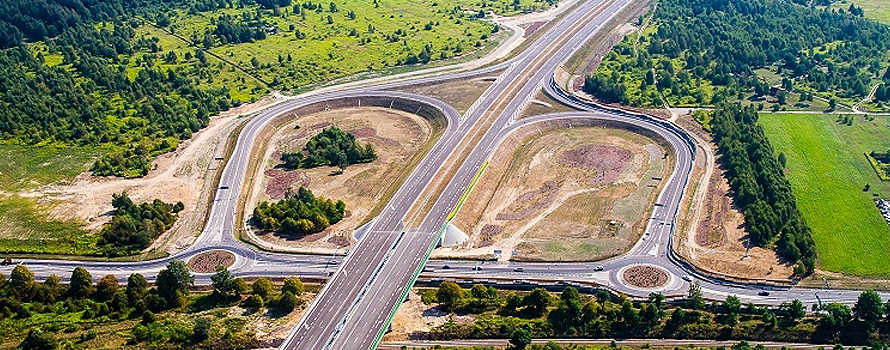
▲Polish motorway section to be part of the project Via Carpatia [Generalna Dyrekcja Dróg Krajowych i Autostrad Oddział w Rzeszowie].
article / Paula Ulibarrena
Via Carpatia is a European route; it is actually an ambitious project interstate motorway linking the Baltic Sea and the Black Sea. The route will start in Lithuania, in the city of Kaunas, then continue through Poland, following the Bialystok-Lublin-Rzeszów route; it will then enter Slovakia to cover the Presov-Kosz section, and in Hungary it will run through Miskolc-Debrecen.
On the territory of Romania, the route will be divided into two directions, one towards the port of Constanta on the Oradea-Arad-Timisoara-Lugoj-Deva-Sibiu-Pitesti-Bucarest-Constanta route and the other penetrating into Bulgaria via the future bridge over the Danube at Calafat-Vidin and with the possibility of extending the project to Greece, in the Mediterranean, at the southern border of the European Union.
The project Via Carpatia was C in 2006, when the transport ministers of Poland, Lithuania, Slovakia and Hungary signed a joint declaration to extend the network trans-European transport network by creating a route to connect these four states along a north-south axis. In 2010, project was joined by Romania, Bulgaria and Greece to extend the new route through their respective territories.
Andrzej Adamczyk, Poland's Minister of Public Works, said in May 2017 that the entire 600-kilometre route of this infrastructure in Poland will be completed by 2025. According to him, Via Carpathia "will allow the full potential of the provinces it passes through to be developed, providing a boost for the poorer regions of eastern Poland and the economies of the area".
The purpose of project is to promote the economic development of the region, providing facilities for the development of small and medium-sized business and the creation of technology parks, which should contribute to the creation of employment and enhance research and innovation.
This initiative currently reinforces other policies that also have the goal development of infrastructures in Eastern Europe, such as the 3 Seas Initiative. But it also opens the door to other more ambitious projects, such as the 16+1 and the new Silk Road, both launched by the People's Republic of China.
Connection with China
The 16+1 mechanism is a Chinese initiative aimed at intensifying and expanding cooperation with 11 EU Member States from Central and Eastern Europe (CEE) and 5 Balkan countries (Albania, Bosnia and Herzegovina, Bulgaria, Croatia, the Czech Republic, Estonia, Hungary, Latvia, Lithuania, Macedonia, Montenegro, Poland, Romania, Serbia, Slovakia, Slovenia) in subject investment, transport, finance, science, Education and culture. In the framework of the initiative, China has identified three possible priority areas for economic cooperation: infrastructure, high technologies and green technologies.
The Riga Declaration, a document issued in November 2017 at the China-ECO summit, sets the roadmap for such cooperation. In the Latvian capital, Chinese Premier Li Keqiang and the leaders of Central and Eastern European countries agreed to enhance cooperation internship and increase people-to-people exchanges. In particular, the leaders reaffirmed their desire to achieve effective connectivity between ports on the Adriatic, the Baltic and the Black Sea, through roads and the use of inland waterways.
"The Adriatic-Baltic-Black Sea port cooperation will be a new engine for China-ECO cooperation," said Liu Zoukiu, researcher of the Chinese Academy of Social Sciences, adding that the combination of Chinese equipment, European technology and ECO markets will be a great model for cooperation between China and these 16 nations.
Trade between China and Central and Eastern European countries reached $56.2 billion in 2015, up 28 per cent from 2010. Chinese investment in these 16 nations exceeded $5 billion, while in the opposite direction investment was $1.2 billion.
issue The data also shows that the number of goods train lines between China and Europe has increased to 39 since the connections began in 2011. 16 Chinese cities regularly operate these convoys to a dozen European cities. Beijing's interest in the CEE countries lies precisely in the fact that they are Europe's gateway to the new Silk Road.
|
The future north-south connection, Baltic-Black/Mediterranean [viacarpatia.eu]. |
The European Gateway to the New Silk Road
The 21st Century Silk Road, which the Chinese government has dubbed One Belt One Road (OBOR), is not an institution with clearly defined rules, but rather a strategic vision: it alludes to the ancient Silk Road, the commercial and cultural link between East and West for more than two millennia. The new route aims to be a connectivity network consisting of maritime and land-based economic corridors linking China and the rest of Asia with the Middle East, Europe and Africa. In this way, OBOR puts continents, oceans, regions, countries, cities, international and regional organisations on contact .
The new diplomatic language appears as a seductive tool of Chinese soft power, exported through the routes of trade and diplomacy that reach the gates of Europe. Evoking the historical framework of harmonious coexistence and mutual cultural enrichment, Chinese officialdom defines the "Five Principles of Peaceful Coexistence" as OBOR's core values: (1) mutual respect for sovereignty and territorial integrity; (2) agreement mutual non-aggression; (3) agreement mutual non-intervention in internal affairs; (4) equality and mutual benefit; (5) peaceful coexistence.
China seeks to diversify its trade routes and partners, opening up new consumer markets. At the same time, it is securing supplies of energy and raw materials. Finally, it is expanding its logistical structure and building a China-centred trade network .
Beijing set up a state investment fund, the Silk Road Fund, in 2014 with a capital of $40 billion, earmarked for One Belt, One Road investments. China insists that such financial institutions are not intended to replace existing ones, but rather to complement and collaborate with them in a spirit of inclusiveness and mutual benefit. However, voices from the United States and the European Union have raised some concerns.
US and EU suspicions
US analysts speak of the Chinese European Century (and warn that as investment and trade with Europe grows, so will Beijing's influence over European policies. Indeed, the Asian Infrastructure Investment Bank (AIIB) already has funds of $100 billion, or 50 per cent of the World Bank's capital.
The 16+1 platform was launched to the chagrin of the EU, which was not consulted on the matter beforehand. Brussels observes a status of dependency on the part of some of the continent's poorest countries, caused by a trade asymmetry in favour of China: trains arrive in Warsaw with tons of Chinese goods, but return half-empty. The creation of infrastructure and new production and distribution centres for Chinese goods sometimes progresses beyond the EU's control. Consequently, EU legislative compliance and even European unity itself may be affected.
For the most part, the national interests of European countries seem to be dominated by the pure logic of Economics and lack strategic vision. They have so far made a common and coordinated EU policy towards OBOR impossible. In the absence of unity, Europe is throwing stones at itself and ironically applying to itself the effective "divide and rule" strategy described by the Chinese philosopher Sunzi 2,500 years ago.
New international order
The international order is changing: OBOR, which in paternalistic embrace now encompasses almost all European countries, presents itself as the Chinese alternative to the West's model that has dominated the world until now.
The US is being replaced as the world's leading Economics and losing its political hegemony to the rise of China. This is demonstrated by the reactions of Washington's staunchest allies in Europe, London and Berlin, in joining the OBOR initiative without much hesitation and despite US warnings.
China proposes to create a new international economic and financial order together with Europe. The most notorious milestone of this close partnership is China's injection of up to €10 billion into the EFSI, a decision agreed between Beijing and Brussels in April 2016, making China the largest investor in the so-called Juncker Plan. Together, they can generate economic growth and the creation of employment by building and modernising infrastructure networks that improve intra-European connectivity. This can facilitate the opening up of European products and services for export to new markets and improve their conditions for entrance to China's own market. Europe can benefit from improved connectivity with other hitherto remote regions.
Domestic demand will increase, unlike in more advanced regions
In the coming decades, oil consumption in Latin America will continue to grow, in the face of a trend towards leave which is already on the horizon of many advanced countries. Population growth and the increase in class average explains this increase in demand. This domestic demand will serve to strengthen the extractive industries of Latin American crude oil producers, but it will make the region's refining deficit chronic.

article / Ignacio Urbasos
The oil industry is experiencing a change in export and consumption patterns in the Latin American region. The sector's classic orientation towards the United States has changed in a new context in which exports are much more diversified with a tilt towards emerging Asian countries. Similarly, domestic demand is steadily increasing due to population and economic growth. However, the region's refining capacity will remain inadequate. This paper will offer a long-term analysis to try to offer a better understanding of the region's energy future, mainly in its consumption, extraction and subsequent refinement.
First of all, Latin America's demographic and economic expectations must be taken into account: population growth will increase by 800 million people by 2050, and economic growth could be 2% per year for at least the next decade. The direct effect of this will be the increase in electricity demand by 91% by 2040 and the increase in issue of vehicles in the region from 94 million in 2016 to the 165 million expected by 2040.
As can be seen in the graph below, the greater demand for oil in the region will be associated with transport, which will tend to be more efficient in consumption, but the promised arrival of the electric car is still far away, with expectations of less than 4% by 2030 worldwide. Similarly, the increase in the class average 126 million people by 2030 will have a direct impact on the increase in air travel, which is projected to grow by average 3.4% per annum until 2034, agreement to the last report of ICAO, with a consequent increase in kerosene consumption.
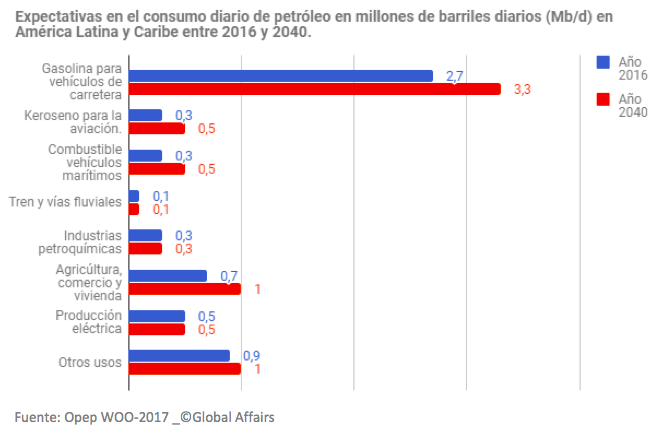 |
It should be borne in mind that in Latin America there are subsidies for both gasoline and diesel, which generates more affordable prices and distorts demand clearly upwards. These subsidies respond mainly to the logic that citizens should be beneficiaries of their country's possession of natural resources, and are concentrated in traditionally oil-producing countries such as Ecuador, Venezuela, Mexico or Argentina. However, these countries import fuel to a large extent due to their limited refinery capacity, generating a double trade and fiscal deficit, as ECLAC points out. The future of these subsidies is unknown, but any change would have a high political cost, since by affecting the price of a basic good it would have consequences on broad social sectors with great electoral impact.
For its part, oil's contribution to electricity generation will remain constant at 500,000 barrels per day, decreasing its importance from the current 46%, according to figures for Latin America from the International Renewable Energy Agency. The region will benefit enormously from the increased presence of renewable energies, a sector that it already leads due to incomparable geographical conditions, highlighting the enormous importance of hydropower.
Over the next few decades, two major phenomena will occur in Latin America: the universalization of access to energy and a new model energy with less presence of oil and biofuel (wood and waste) in favour of gas and alternative energies. One of the great challenges facing the region is to develop a more integrated electricity system nationally and internationally that increases consumption efficiency and allows greater flexibility in production sources. The geographical uniqueness of the region requires enormous investments to carry out this task; however, there are already several regional projects in this direction: the Andean Electrical Interconnection System, which includes the countries of the Andean Community plus Chile, and the Central American Electrical Interconnection System (SIEPAC).
Refining deficit
This increase in consumption is not accompanied by greater refinery capacity, which is already enormously deficient, and generates a critical dependence on imports of gasoline and other derivatives from the US. A trend that is likely to be a constant in the short and medium term for the region and is added to the 14% decline in refinery activity in the region since 2012 (World Oil Outlook 2017), which already adds up to a loss of one million refined barrels per day since that year. High installation and maintenance costs, around 2% of the annual installation cost, add to the region's chronic political uncertainty that largely scares away private investment.
An illustrative case is that of the Pacific refinery in Ecuador, which was presented as the largest project refinery in the country at the beginning of Rafael Correa's presidency in 2007. The project began with a financial stake of 49% by PDVSA and 51% by Petroecuador, in addition to the award of the project to the construction company Odebrecht. As of today, PDVSA has withdrawn its contribution and the Brazilian construction company is facing trials in the country for corruption. result a lost decade and forcing Lenin Moreno to reformulate the project, including the name: now Manabi Refinery.
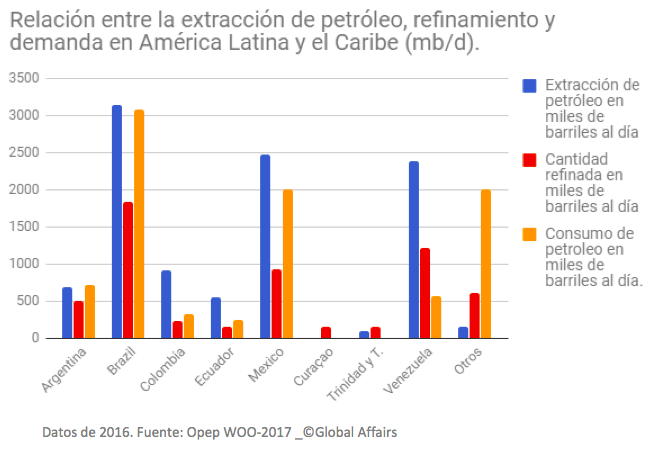 |
As we can see in the graph, the large oil producers in Latin America have a deficient refinery capacity. It should be borne in mind that there is not only an undercapacity in the region, but also an under-activity, which creates an even greater gap. The activity of these plants is currently around 70% of their total capacity. Those countries that do not have oil production, but do have a relevant refining industry, are Curaçao, which has one of the largest PDVSA centers, Chile and Peru.
In final, the Latin American oil sector faces the coming decades with enormous doubts about its refining capacity and far from achieving self-sufficiency. The lack of capacity to attract foreign investment from historically oil-producing countries has generated a disappointing scenario that aggravates the already limited industry in the region. The social transformations inherent in a society that is growing demographically and economically require investment in infrastructure in order to meet the expectations of universal access to education. network and the incipient consumption of the incipient class average.
Taiwan imports up to four times more than China from Central American countries that recognize it as a state.
Of the almost two hundred countries in the world, only 19 have diplomatic relations with Taiwan (and therefore do not have diplomatic relations with China). Of these, five are in Central America and four in the Caribbean. The recognition of Taipei has some advantages for these countries, although they have been neutralized by China's commercial weight. Panama established relations with Beijing in 2017 and the Dominican Republic has just done so now. Here we examine the interest that preference for Taiwan still holds for certain Central American countries.
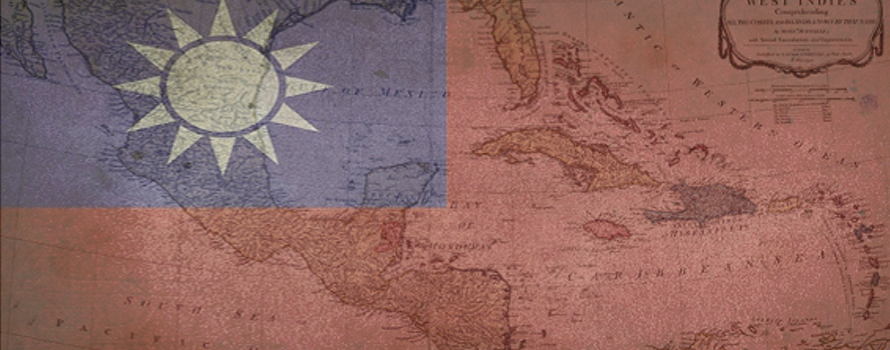
article / Blanca Abadía Moreno
Taiwan's special relationship with Central America dates back to the period following Taiwan's 1971 departure from the United Nations, where Nationalist China was displaced by the People's Republic of China. Several Latin American countries had established relations with Taiwan in the 1960s, but most of them gradually came to recognize Beijing after the UN change. Taiwan retained, however, the support of the Central American nations and in the 1980s also gained the support of small Caribbean islands that then became independent.
The emergence of China as a major international trade partner has been subtracting diplomatic recognition from Taiwan. Costa Rica established full ties with China in 2007, Panama in 2017 and the Dominican Republic last May 1. Even so, of the 19 countries that continue to opt for Taipei over Beijing, five are in Central America: Guatemala, Belize, Honduras, El Salvador and Nicaragua (this country with a five-year hiatus, from 1985-1990). Four others are in the Caribbean: Haiti and three tiny nations in the Lesser Antilles. If one takes into account that the rest of the countries that recognize Taiwan are of little commercial importance, except for Paraguay (they are the Vatican, Burkina Faso, Swaziland and six Polynesian microstates), it is understandable that Central America absorbs Taiwan' s diplomatic interest.
Since the constitutive theory of statehood defines a state as a person in international law if, and only if, it is recognized as sovereign by others, Taiwan strives to ensure that those countries continue to recognize it as a subject of plenary session of the Executive Council law in the concert of nations; losing their support would directly affect the legitimacy of its claims as a sovereign state.
To this end, Taipei promotes trade relations with them, procures investments and uses what is called "checkbook diplomacy": submission of gifts (and bribes) to maintain these relations. Central American countries receive an average of $50 million annually in declared non-reimbursable cooperation. Taiwan directs financial aid to its Latin American partners through the development and International Cooperation Fund(ICDF), with programs ranging from infrastructure construction to coffee production. Taiwan has financed and constructed several government buildings in Nicaragua and El Salvador.
In addition, the Asian nation contributes to programs of the Central American Bank for Economic Integration (CABEI) and is an observer country in the Central American Parliament and other regional organizations.
This effort, however, has not prevented that in recent years there have been casualties among Central American countries that saw him giving diplomatic recognition. Costa Rica's economic development led the country in 2007 to want to improve its trade figures through a rapprochement with China, which involved the opening of an embassy in Beijing and the closure of the one it had in Taipei. For the same reason, Panama also opted in 2017 to break off diplomatic relations with Taiwan, stating that China, a prominent Username of the Panamanian canal, "has always played a relevant role in Panama's Economics " and any restrictions preventing it from remaining so had to be removed.
 |
Commercial relations
Trade relations between Taiwan and the Central American countries that recognize it as a State increased significantly thanks to the opening of the Central American Trade Office(CATO) in Taiwan in 1997, the incorporation of this country into CABEI and the entrance entry into force of several trade agreements. Taiwan signed free trade agreements with Guatemala (2006), with Honduras and El Salvador (2006) and with Nicaragua (2008).
These treaties have especially facilitated Central American exports to Taiwan. As is the case with most Latin American countries, Guatemala, El Salvador, Honduras and Nicaragua have China as one of the main origins of their imports (the first is still the United States). Their political alignment with Taiwan does not prevent them from being customers of Chinese production. Thus, in 2016, China ranked between 2nd and 3rd as a source market, while Taiwan ranked far down the table (between 14th and 23rd). However, the special relationship with Taipei means that Taiwan equals or surpasses China as a destination for the exports of the four Central American countries mentioned. This is the commercial benefit they obtain from the diplomatic recognition of the Asian island.
Of this group of countries, Nicaragua exported the most to Taiwan in 2016 (US$83.7 million) compared to exports to China (US$21.5 million), a ratio of four to one. The main Nicaraguan products exported were shrimp, sugar, beef and coffee.
Honduras exported US$24.7 million to Taiwan -mainly textiles, coffee and aluminum- compared to US$18.5 million to China. El Salvador sent shipments to Taiwan worth US$53.3 million - mainly sugar - and US$46.5 million to China. Guatemala, whose Economics has a larger volume, was the only country to sell more to China (75.5 million), but in figures very similar to those of Taiwan (74 million), to which it sent mainly coffee, paper and cardboard.
With these diplomatic and commercial relations Taiwan intends to show international society that it is a capable ally and manager for international cooperation. It also wants to show the world that Taiwanese diplomacy exists despite China's attempts to isolate it. The fact that China has a special interest in markets that facilitate access to raw materials makes the Asian giant more attentive to relations with several South American countries, rich in minerals; it is there where Beijing concentrates its Latin American investments.
Central America, with less extractive activity, thus escapes China's priority (the interest in the Panama Canal is a case apart), and is left for the time being to Taiwan's action. However, the increasingly residual nature of support for the island and the very weight of relations with China suggest that the Central American countries will continue to join this particular club, one after the other, from leave.
Nearly two-thirds of the world's identified lithium reserves are in Bolivia, Chile and Argentina
The explosion of the electric automotive industry through the use of lithium-ion batteries has put the large reserves of this metal in the Bolivian highlands and the Atacama Desert at the center of global interest in this new industry. Will South America take advantage of the opportunity to enter into processes of technological innovation itself, or will it resign itself, as has happened with so many other minerals, to a mere work of extraction?
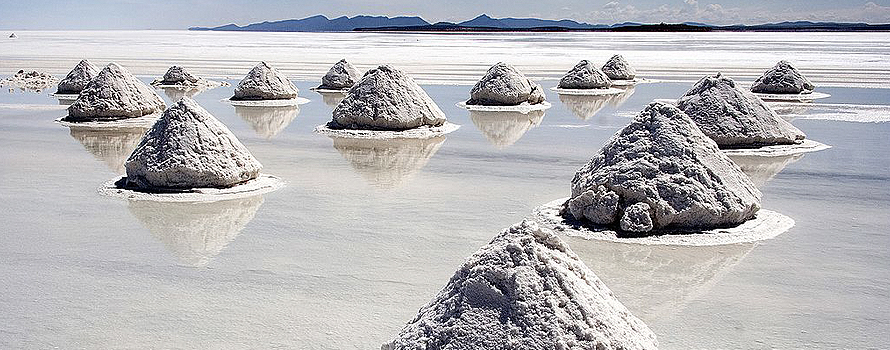
▲Salar de Uyuni, in the highlands of Bolivia [Luca Galuzzi, Wikimedia Commons]
article / Milene Pardo-Figueroa
With the gradual introduction of electric vehicles into the market, as well as the increase in the sale of smartphones, laptops, tablets and other electronic devices – all of which are powered by lithium-ion batteries – the global demand for lithium is increasing. This alkaline chemical element, which in its pure form occurs as a soft, particularly light metal, is abundant in nature, although the largest reserves are concentrated in a few countries. Due to the conditions of its extraction, it is especially profitable in the dry areas of the triangle bounded by the borders of Bolivia, Chile and Argentina. If lithium is known as "white oil" or "new gasoline", because of the color of the saltpeter of the deposits where it is found and because it is the driving force of modern automobiles, the border area of these countries is called the "Saudi Arabia of lithium".
The lithium "fever" has led to a current production of 40,000 tonnes per year, a figure that falls short of the huge demand that currently poses a need of 180,000 tonnes. Although this volume may be reached in the coming years, estimates speak of a demand of between 500,000 and 800,000 tons in 2025. By then, agreement With some forecasts, the global lithium battery market could be worth $46 billion. Part of the industry's push comes from the innovation of electric cars. The expansion of that market, however, could be slowed if lithium production is not accelerated. As visionary entrepreneur Elon Musk, promoter of the high-end electric car brand Tesla, has warned, "in order to create 500,000 vehicles a year, we basically have to retain all the lithium generation on the planet."
The difficulty in meeting this growing demand comes from the high extraction costs, which vary considerably depending on the characteristics of the deposit. The most profitable deposits are found in brine concentrates in arid climates, which experience rapid evaporation when brought to light. The place where this especially happens is the area formed by the Atacama Desert and the Bolivian highlands.
World production is led by Australia, which in 2016 extracted 14,300 tonnes, followed by Chile, with 12,000, and Argentina, with 5,700, of all tonnes. agreement with figures from the U.S. Geological Survey . The volume of reserves identified places the South American countries clearly ahead, especially Bolivia, which has the largest deposits, although for now there are development There is little mining activity for this metal. Thus, Bolivia has identified reserves of 9 million tonnes (22.7% of the world total), Chile 7.5 million (18.9%) and Argentina 6.5 million (16.4%), which means that the three countries have 58% of the world's reserves. They are followed by the United States, with 5.6 million (13.9%), and China, with 5.4 million (13.6%). Other estimates give China reserves similar to Argentina's. The sector is dominated by five large companies, which control 90% of global production: SQM (Chile), FMC and Albermarle (USA), Talison (Australia) and Tianqi Lithium (China).
|
The Lithium Triangle |
Lithium reserves identified |
The White Triangle
The Salar de Uyuni in the Bolivian highlands – a salt-covered surface generated by the evaporation of seawater that was enclosed in a lake when the Andes mountain range emerged in its training– is home to what could be the world's largest lithium deposit. Obtaining it faces the problem that here the metal is specially mixed with magnesium and the separation of the two requires access to technology that Bolivia does not currently have on a large scale. Faced with the fear that foreign companies will be the ones to control the extraction and leave little benefit to the country, as happened historically with the development For the time being, the government of Evo Morales has opted for limited exploitation. Bolivian authorities have preferred to prevent the penetration of multinationals, in order to ensure that the South American nation maintains control of the business. Morales has announced plans for the commissioning, with public funding, of a facility for the manufacture of lithium carbonate at the Uyuni salt plant.
Lithium exploitation is much more advanced in Chile, a country that accounts for around 33% of the world's supply, thanks to the large deposits in the Atacama Desert and the development of an industry of its own. The Society Chemistry and Minera de Chile (SQM), a private Chilean company, leads the national sector, where concessions are tightly controlled by the state. For its part, Argentina is taking steps to boost the lithium business; To that end, the government of Mauricio Macri is proceeding with the liberalization of the sector and has established contacts to attract foreign capital.
Beyond the economic benefits that these South American countries can obtain from the lithium mining boom, a discussion about the ecological impact that it can cause in places as unique due to their natural characteristics as Atacama or Uyuni; There are voices that warn that the Andean saline solution may be doomed to disappear in order to satisfy foreign interest in batteries. There are also fears of a social impact, with no compensation for the human groups settled in the affected territories.
On the other hand, the negative impact that the perpetuation of an economic culture of extraction has historically had in Latin America advises Bolivia, Chile and Argentina to take advantage of the occasion to try to develop their own transformation initiatives and new technologies in the generation of batteries, without limiting themselves, as is the case with so many other minerals, to an extractive activity.
Kenya has the first section of the new railway network financed with financial aid from Beijing.
Africa's participation in the New Silk Road promoted by China involves connecting the hinterland of several East African countries with the main ports on their Indian coast. The designed railway network , which introduces standard gauge in the region, has begun to operate between the two main cities of Kenya: Nairobi and the port of Mombasa. But the full realisation of the project is subject to the questionable model of Chinese investment.
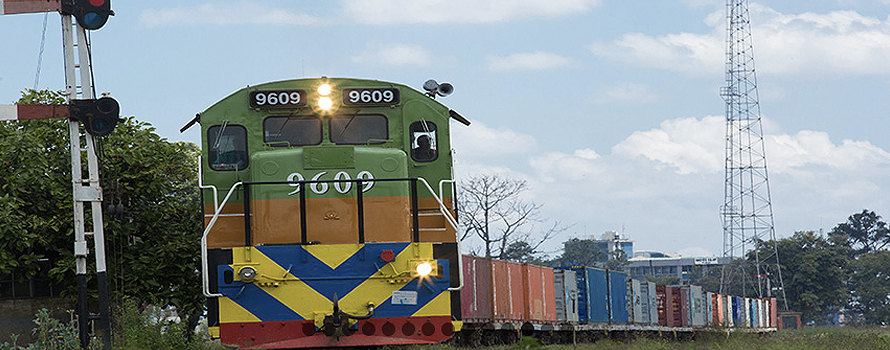
▲Freight transport between Nairobi and Mombasa [Kenya Railways] ▲Freight transport between Nairobi and Mombasa [Kenya Railways].
article / Claudia Correa and Alexia Cosmello
Sino-African relations date back to the 15th century when Zhang, the navigator and trader, arrived on the shores of Mozambique. However, it was with Mao Zedong in 1949 that real relations were established. With promises of respect and taking into account the wounds left by colonisation, China has economically assisted Africa to become its main economic partner since 2009. Through the implementation of economic and technological cooperation projects, it has financed the construction of hydroelectric power plants, dams, airports, aqueducts, hospitals, refineries, gas pipelines, railways and highways in 52 of Africa's 54 countries.
Cooperation between China and Africa has grown considerably. Since 2000, ministerial conferences of the Forum on China-Africa Cooperation (FOCAC) have been held, increasing trade and partnership in areas such as Education, science, technology and health. On the other hand, in terms of lending and investment, China has announced that it will allocate a large part of its capital to projects on the African continent. In 2013, for example, Chinese President Xi Jinping pledged €14.4 billion for infrastructure built by Chinese companies, while in 2014 Premier Li Keqiang announced that China would allocate an additional €8.6 billion to development projects in Africa.
China's rise and intention to broaden and deepen its influence in the world has been very clear in recent years. In September 2013, Xi Jinping presented a new public works expansion project called the New Silk Road. With the goal to gain a foothold in world trade, China aims to improve Asia's connections with other regions by building land routes and articulating a sea route to facilitate trade. Although it is an initiative that will be useful for the international community, it is important to stress the benefits for Africa, since the East African transport route network will be built on its territory, which will give that part of the African continent greater access to world trade, as well as new infrastructure with cutting-edge technology.
Standard Gauge Railway
The network East African freight and passenger goal is intended to connect Kenya's major cities with Uganda's capital Kampala, Burundi's capital Bujumbura, South Sudan's capital Juba and Rwanda's capital Kigali. It is planned to apply standard gauge to most of the route, so the project is known as Standard Gauge Railway (SGR). It is estimated that the network railway will be around 2,935 kilometres in total and will cost around $13.8 billion. position The majority of the financing will be provided by the Chinese government, with financial aid and EiximBank, which will finance 90% of the construction costs, while the Kenyan government will finance the remaining 10% only. The work will be carried out by the Chinese business Road & Bridge Corporation, which is considered to be the most entrepreneurial public business presence in Africa.
The first phase of project, called the Madaraka Express, is now complete and was inaugurated in May 2017. The initiative involved the construction of a railway line to link Nairobi, the capital of Kenya, with Mombasa, the most important port city in Kenya and East Africa. The train can carry 1,260 passengers over a distance of approximately 470 km. With one of the key parts of the network transport network already built, it is possible to continue with the project and move on to the second phase, which will consist of extending the railway lines to the rest of the cities mentioned above.
|
project of the new railway network [Kenya Railways]. |
China's Investment Challenges
What are China's purposes for investing in Africa? It probably does so because it is a large potential market for the sale of its products, as well as a large source source of natural resources. In East Africa, for example, there is oil in Kenya or materials essential for mobile phone batteries in Malawi. In any case, it is clear that this is not a charitable act on the part of the Chinese, as it has been shown that Chinese banks and companies offer financing because it allows them to secure a larger market share in Africa as part of their strategy to go global.
According to Chinese Premier Li Keqiang, "cooperation with Africa is based on respect, equality and mutual benefit". African representatives are enthusiastic about China's investment in Africa's development . The Kenyan president declared that the new train will "revolutionise the region's Economics and reaffirm Kenya's status as an economic hub", and Malawi's ambassador Wang Shiting expressed his thoughts on Africa's development , posting that Africa will only improve when everyone contributes to its development, and that is precisely what China is currently doing.
According to agreement with these official views, from the African point of view, China's intervention on the continent is not seen as negative. However, it does present certain problems, such as the suspicion and accusation of corruption by Chinese investors or the claim that it is aggravatingly widening the economic gap between the more and less well-off, as Chinese investors understandably expect to do business with the continent's elites. There is also the mistreatment of the environment, such as the controversy over the environmental impact of the aforementioned network railway, especially in Kenya, where people have questioned the route through Nairobi Park because of the environmental impact.
It is not only Chinese companies that are investing on the African continent; some Western and European companies have, in some cases, replaced Chinese companies. A prime example is the US multinational General Electric, which in just one year has tripled its workforce in Nigeria, Kenya and Ethiopia. This is possible as a result of the delays or paralysis that some projects have suffered due to the sudden drop in raw material prices and the Chinese slowdown. Thanks to this, some African states with sufficient financial structure have taken the initiative themselves not to let the projects be buried.
July 1 presidential election does not open a serious discussion on the fight against drug trafficking
The 'iron fist' that Felipe Calderón (PAN) began in 2006, with the deployment of the Armed Forces in the fight against drugs, was extended in 2012 by Enrique Peña Nieto (PRI). In these twelve years the status has not improved, but rather increased violence. In this 2018 elections none of the main candidates presents a radical change from model; the populist Andrés Manuel López Obrador (Morena) proposes some striking measures, but continues to count on the work of the Army.
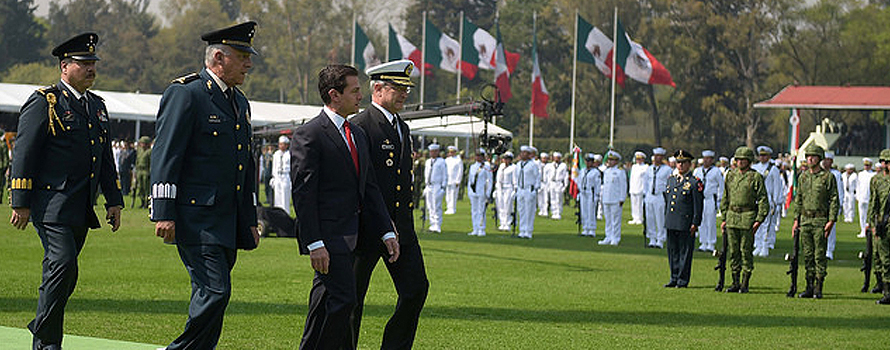
▲The Mexican president on Flag Day, February 2018 [Presidency of the Republic].
article / Valeria Nadal [English version].
Mexico faces a change of sexenio after closing 2017 as the most violent year in the country's history, with more than 25,000 homicides. How has this status been reached ? Can it begin to be resolved in the coming years?
There are several theories about the beginning of drug trafficking in Mexico, but the most widely accepted argues that Mexican drug trafficking was born when Franklin Delano Roosevelt, president of the United States between 1933 and 1945, promoted the cultivation of poppy in Mexican territory with the veiled intention of promoting the production of large quantities of morphine to relieve the pain of U.S. soldiers during World War II. However, drug trafficking was not a serious national problem until the 1980s; since then, cartels have multiplied, violence has increased and crime has spread throughout Mexico.
The new phase of Felipe Calderón
In the fight against drug trafficking in Mexico, the presidency of Felipe Calderón marked a new stage. candidate of the conservative National Action Party (PAN), Calderón was elected for the six-year term 2006-2012. His program included declaring war on the cartels, with a "mano dura" (iron fist) plan that translated into sending the Army to the Mexican streets. Although Calderón's speech was forceful and had a clear goal , to exterminate insecurity and violence caused by drug trafficking, the result was the opposite because his strategy was based exclusively on police and military action. This militarization of the streets was carried out through joint operations combining government forces: National Defense, Public Security, the Navy and the Attorney General's Office (PGR). However, and despite the large deployment and the 50% increase in the expense in security, the strategy did not work; homicides not only did not decrease, but increased: in 2007, Calderón's first full presidential year, 10,253 homicides were registered and in 2011, the last full year of his presidency, a record 22,409 homicides were registered.
According to agreement with the high school of Legal Research (IIJ) of the National Autonomous University of Mexico (UNAM), in that record year of 2011 almost a quarter of the total Mexican population over 18 years of age (24%) was assaulted in the street, suffered a robbery in public transport or was a victim of extortion, fraud, threats or injuries. The fees of violence was so high that it surpassed those of countries at war: in Iraq between 2003 and 2011 there was a average of 12 murders per day per 100,000 inhabitants, while in Mexico that average reached 18 murders per day. Finally, it is worth mentioning that the number of complaints about this indiscriminate wave of violence was quite high leave: only 12% of the victims of drug-related violence reported. This figure is probably related to the high rate of impunity (70%) that also marked Calderón's mandate.
Peña Nieto's new approach
After the failure of the PAN in the fight against drug trafficking, in 2012 Enrique Peña Nieto, candidate of the Institutional Revolutionary Party (PRI), was elected president. With this, this party, which had governed for uninterrupted decades, returned to power after two consecutive six-year periods of absence (presidencies of Vicente Fox and Felipe Calderón, both from the PAN). Peña Nieto assumed the position promising a new approach , contrary to the "open war" proposed by his predecessor. He mainly focused his security policy on the division of the national territory into five regions to increase the efficiency and coordination of operations, on the reorganization of the Federal Police and on the strengthening of the legal framework . However, the new president maintained the Army's employment in the streets.
Peña Nieto's results in his fight against drug trafficking have been worse than those of his predecessor: during his term, intentional homicides have increased by 12,476 cases compared to the same period in Calderón's administration and 2017 closed with the regrettable news of being the most violent year in Mexico to date. With just months to go before the end of his six-year term, and in a last-ditch effort to right the wrongs that have marked it, Peña Nieto brought about the approval of the Internal Security Law, which was voted by Mexico's congress and enacted in December of last year. This law does not remove the military from the streets, but intends to legally guarantee that the Armed Forces have the capacity to act as police, something that previously only had the character of provisional. According to the law, the military participation in daily anti-narcotics operations is not to replace the Police, but to reinforce it in those areas where it is incapable of dealing with drug trafficking. The initiative was criticized by critics who, while recognizing the problem of the scarcity of police resources, warned of the risk of an unlimited military deployment over time. Thus, although Peña Nieto began his term in office trying to distance himself from Calderón's policies, he has concluded it by consolidating them.
|
source: Executive Secretariat, Government of Mexico |
What to expect from the 2018 candidates
Given the obvious ineffectiveness of the measures adopted by both presidents, the question in this election year is what anti-drug policy the next president will adopt, in a country where there is no re-election and therefore every six-year presidential term means a change of face. The three main candidates are, in the order of the polls: Andrés Manuel López Obrador, of the Movimiento Regeneración Nacional (Morena); Ricardo Anaya, of the PAN coalition with the Partido de la Revolución Democrática (PRD), and José Antonio Meade, of the PRI. López Obrador came close to reaching the presidency in 2006 and 2012, both times as candidate of the PRD (he had previously been leader of the PRI); he then created his own party.
Meade, who represents a certain continuity with respect to Peña Nieto, although in the electoral campaign he has adopted a more anti-corruption tone, has pronounced himself in favor of the Internal Security Law: "It is an important law, it is a law that gives us framework, that gives us certainty, it is a law that allows the participation of the Armed Forces to be well regulated and regulated". Anaya has also positioned himself in favor of this law, since he considers that a withdrawal of the Army from the streets would be "leaving the citizens to their fate". However, he supports the need for the Police to recover its functions and strongly criticizes the lack of responsibility of the Government in subject of public security, alleging that Mexico has entered a "vicious circle that has become very comfortable for governors and mayors". In any case, neither Meade nor Anaya have specified what turn they could take that would be truly effective in reducing violence.
López Obrador, from a left-wing populist stance, is a major change with respect to previous policies, although it is not clear how effective his measures could be. Moreover, some of them, such as granting amnesty to the main drug cartel leaders, seem clearly counterproductive. In recent months, Morena's candidate has changed the focus of his speech, which was first centered on the eradication of corruption and then focused on security issues. Thus, he has said that if he wins the presidency he will assume full responsibility for the country's security by integrating the Army, the Navy and the Police into a single command, to which a newly created National Guard would be added. He has also announced that he would be the only one to assume the single command: "I am going to assume this responsibility directly". López Obrador pledges to end the war against drugs in the first three years of his mandate, assuring that, together with measures of force, his management will achieve economic growth that will translate into the creation of employment and the improvement of welfare, which will reduce violence.
In conclusion, the decade against drug trafficking that began almost twelve years ago has result been a failure that can be measured in numbers: since Calderon became president of Mexico in 2006 with the slogan "Things can change for the better", 28,000 people have disappeared and more than 150,000 have died as a result of the drug war. Despite small victories for Mexican authorities, such as the arrest of Joaquin "El Chapo" Guzman during the Peña Nieto presidency, the reality in Mexico is one of intense criminal activity by drug cartels. From the electoral proposals of the presidential candidates, no rapid improvement can be expected in the next six years.

![The main Russian gas pipelines to Eastern and Central Europe [Samuel Bailey/CC]. The main Russian gas pipelines to Eastern and Central Europe [Samuel Bailey/CC].](/documents/10174/16849987/nordstream-blog-2.png)
